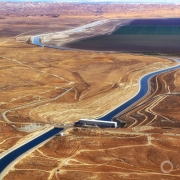Wisconsin Groundwater Dispute Is a Warning Signal for the Eastern United States
Water problems in states east of the Mississippi River mirror those of the dry American West.

When it pulled back from the North American mid-continent roughly 10,000 years ago, the Laurentide Ice Sheet left the state of Wisconsin a lovely basket of geological parting gifts: rich soils, sculpted terrain, and a dimpled landscape.
The glacial retreat laid the foundation for Antigo silt loam, the official state soil and an asset still drawn upon by farmers in north-central Wisconsin. Glacial floods sliced open the cliffs of the Dells, a popular mid-state tourist attraction. Soon after the glaciers receded, the dimples filled with water and formed many of Wisconsin’s 15,000 lakes.
Today, a hydrological reversal is taking place. Some of the lakes are shrinking, victims of high-capacity groundwater wells that pump more than 378,000 liters (100,000 gallons) per day and are used by big farms, dairies, and companies mining silica sand for use in the fracking industry. The state Legislature is discussing the matter. Lawmakers introduced three bills this session that seek, in various ways, to preserve Wisconsin’s waterscape.
“We have to accept that navigable waters have been impacted and we have to act,” said Rep. Scott Krug, a Republican who co-sponsored one of the bills, according to the Wisconsin State Journal.
It is unfamiliar territory for the damp state, but Wisconsin has plenty of company in that regard. Depleted groundwater tables, shrinking lakes, and faltering rivers — problems most commonly associated with the dry American West — are spreading eastward.
Arkansas, for instance, uses more groundwater than any state except Nebraska and California. The alluvial aquifers adjacent to the Mississippi River, of which Arkansas is the biggest user, have been depleted by 26 percent. Most of that depletion occurred in the last 35 years.
“The aquifer can handle only half of what we’re pumping out of it,” Edward Swaim, water division manager for the Arkansas Natural Resources Commission, told me in May 2014. “We’re getting near peak use.”
Booming industrial or municipal demand can stress an aquifer, but the primary culprit is the growth of irrigated agriculture. Irrigation has steadily increased in the states east of the Mississippi River. Three decades ago only two non-western states ranked among the nation’s top 15 irrigated states. Today five are in the upper tier, with Georgia, Mississippi, and Missouri having joined Arkansas and Florida.
Irrigation provides many benefits: increased yields, more profitable farms, and a hedge against fickle rains or sizzling heat. But pump too much and rivers, lakes, and wetlands suffer. So do lakefront property owners, fishermen, and birders. So do neighbors with a shallow well.
Like an addiction, recognizing the problem is the first step. Doing something about it is another matter.
Iowa, for instance, is attempting to head off disputes before they begin. In June, state regulators approved new rules for exercising tighter control over withdrawals in critical zones of the Jordan Aquifer, the primary water source for many towns in the center of the state.
“Here it’s like we’ve gotten a note that we need to change our oil. In other states, the red check-engine light is flashing,” Michael Anderson, a senior environmental engineer at the Iowa Department of Natural Resources, told the Des Moines Register. “We want to deal with this before it becomes a big problem.”
Arkansas, on the other hand, is copying a page from the western playbook. With federal assistance, the state is building two canal-and-reservoir systems, at a cost of $US 1.3 billion, to bring river water to areas irrigated by groundwater.
In Wisconsin, there is not yet an agreement on what to do, the Wisconsin State Journal reports. Some bills address only the harm done to rivers and lakes — but not groundwater tables or wetlands. Other bills would designate high-priority areas for further study but ease the permitting process for less critical regions. The proposals at hand, it seems, are not appealing to those worried about what’s happening underfoot.
Brett writes about agriculture, energy, infrastructure, and the politics and economics of water in the United States. He also writes the Federal Water Tap, Circle of Blue’s weekly digest of U.S. government water news. He is the winner of two Society of Environmental Journalists reporting awards, one of the top honors in American environmental journalism: first place for explanatory reporting for a series on septic system pollution in the United States(2016) and third place for beat reporting in a small market (2014). He received the Sierra Club’s Distinguished Service Award in 2018. Brett lives in Seattle, where he hikes the mountains and bakes pies. Contact Brett Walton









Leave a Reply
Want to join the discussion?Feel free to contribute!